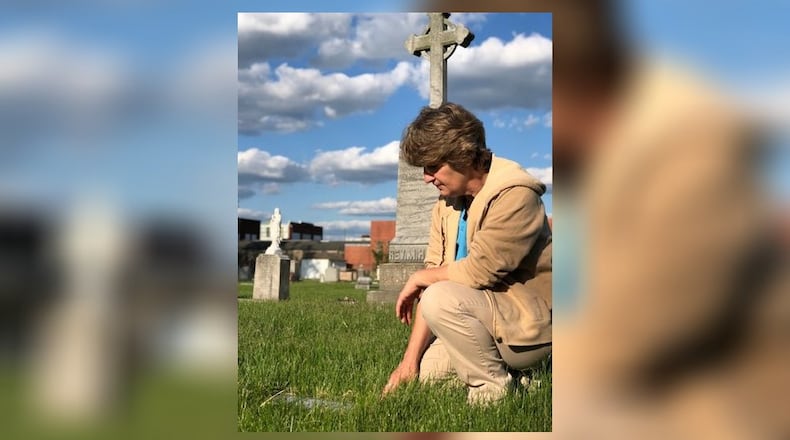Burk loves animals, history, archaeology, traveling, gardening, the classics, and she writes occasional essays and articles, mostly humorous, with a number of published pieces in various areas.
Her husband, Keith C. Lewis, is a graphic artist for the Air Force Research Laboratory at Wright-Patterson Air Force Base.
Burk said their children are of the four-footed variety — horses, dogs, cats, chickens, and one lone goldfish. No human offspring.
“I was asked to fill a seat on the Calvary Cemetery board when a previous member passed away, and since it was an interesting old burial ground with some of our local Catholic history preserved there, I said I would do it,” said Burk.
Until she was asked to serve as a trustee, all she knew was that it was the “Catholic Cemetery” — a mysterious old burial ground on Clark Street a few blocks from Holy Trinity Church. More than 2,000 people have been buried in the cemetery. Early records are limited due to the 1913 flood.
Calvary Cemetery, 112 Clark St., founded in the 1850s, during the pastorate of Father Jeremiah O’Connor of Holy Trinity Parish, was originally known as Holy Trinity Cemetery. Many Irish immigrants settled in the area west of Clark Street known as “Little Dublin.” Today it is the site of Trinity Place Apartments.
Several tombstones are inscribed with Irish names and birthplaces. Central European parishioners from St. John’s Church, and later, St. Mary’s, added a cosmopolitan seasoning to the cemetery role.
Burk writes a short essay about the cemetery for Holy Family parish bulletin, each November, when they hold a collection for cemetery maintenance.
Several years ago, Burk began a Calvary Cemetery Facebook page. Sometimes past photos are posted of people who are buried there.
More than 2,000 people have been buried in the cemetery since its founding; early records are sparse and unfortunately many were lost in the 1913 flood. There are no longer any burial lots for sale, but occasionally someone is still interred in a plot previously purchased by the family.
“There is a section of the cemetery where a number of the clergy are buried,” said Burk. “As you know, Catholic priests are celibate. However, there in that enclosure is one infant grave. As it turns out, my practice manager knew the family and said the infant was stillborn and the family had no money for a burial, so one of the priests there at the time allowed the baby to be interred in the section technically reserved for clergy.”
Despite there being no burial lots for sale, there is still a responsibility to honor the memory of those buried and that requires mainly mowing and groundskeeping work. Upkeep requires money, so with the annual collection held at Holy Family parish, there are investments that keep them solvent.
About the Author
